Reviewed by Anurag Mishra (Sr. Technical Consultant)

Whiteness can be referred to as a measure of how closely a surface matches the properties of a perfect reflecting diffuser i.e. an ideal reflecting surface that neither absorbs nor transmits light, but reflects it at an equal intensity in every direction. For the purposes of this standard, the color of such a surface is known as preferred white. It is the proportion of how hard a surface relates the properties of an ideal reflecting diffuser. For instance, an accurate reflecting surface never absorbs or transmits light. It reflects it at equivalent powers in all the direction.
White color is a symbol of purity and freshness and a marker of opportunity from contaminants. Spectrophotometer construction helps to evaluate the whiteness of plastic films. A white surface reflects light all over the noticeable range while maintaining at a low dimension.
Yellowness is related to dirtying, singing and corruption by light, preparing and synthetic introduction. It is used to evaluate these sorts of debasement with esteem. Yellowness index is measured from spectrophotometric data that explain the change in color of a test sample from clear white to yellow. The test is used to evaluate color changes in a material caused by actual or assumed outdoor exposure. Test sample packaging, preparation and handling influence the test results by changing the surface of the sample. Yellowness index testing is a set of comparative measurements over a long period of time, these factors are defined and written before testing takes place.
Spectrophotometer packaging is highly automated. After indicating the illuminant, reference color and the observer angle, the sample is attached to the sample holder, and the spectrophotometer takes the required readings. Repetitive samples are measured and the average of all the readings are taken.
The TP 800 Spectrophotometer wavelength is used to measure the intensity of electromagnetic energy wavelength. Electromagnetic energy accumulated from the sample enters the device by using an aperture and is separated into its component wavelengths by the holographic grating. Put, the grating acts to differentiate each color from the white light. The separated light is focussed onto a CCD array detector where the intensity of each wavelength is measured by a pixel of the array. The CCD is read-off to a computer and the result is a spectrum that shows the intensity of each wavelength of light.
Various researches have conducted point to point investigations of versatile spectrophotometers with several gauges like American, Japanese and German principles. The L*ab esteem had a distinction under ±1.5 amid the guidelines of many nations.